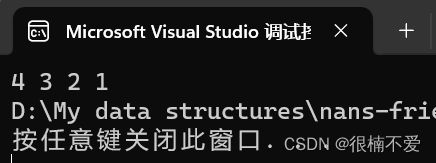数据结构线性表——栈
前言:哈喽小伙伴们,今天我们将一起进入数据结构线性表的第四篇章——栈的讲解,栈还是比较简单的哦,跟紧博主的思路,不要掉队哦。
目录
一.什么是栈
二.如何实现栈
三.栈的实现
栈的初始化
四.栈的操作
1.数据入栈
2.数据出栈
3.返回栈顶数据
4.判断空栈
5.销毁栈
6.测试栈
五.完整代码展示
1.Stack.h
2.Stack.c
3.test.c
六.总结
一.什么是栈
栈,其实是一种特殊的线性表,他只允许在线性表固定的一端进行插入和删除元素的操作。
进行插入和删除的一端称为栈顶,另一端则称为栈底。
栈中的元素遵循后进先出的原则。
其中有两个对栈中元素进行操作的专业名词:
- 压栈:栈的插入操作,也可以叫入栈或进栈,入数据在栈顶。
- 出栈:栈的删除操作叫做出栈,出数据也在栈顶。
二.如何实现栈
经过我们前边的学习,我们已经掌握了数据结构实现的两种方式,数组和链表。
那么对于栈,我们是用数组,还是用链表呢???不妨来分析一下:
关于栈的操作,主要是要方便栈顶的操作。
如果是数组栈:
数组可以直接通过下标来实现访问,方便快捷。
如果是单链表栈:
如果追求高效,就需要让单链表的头作为栈顶,因为单链表的尾部操作比较复杂。
如果是双链表栈,那么无论头尾都可。但是双链表的设计更加麻烦,空间占用也更大。
综合全局因素考虑,用数组实现栈是最合适的。
三.栈的实现
栈的初始化
//初始化
void StackInit(ST* pst)
{
assert(pst);
pst->data = NULL;
pst->capacity = 0;
pst->top = -1;
}栈的初始化和顺序表一样,但是不同于顺序表的是,栈需要一个top,表示栈顶的当前位置,方便对栈顶数据的操作。
值得注意的是,栈是以数组为基础的,而数组的下标是从0开始的,所以我们如果想让top指向当前栈顶的位置,就要初始化为-1,这样每输入一个数据,top++,就可以完全等同于数组下标啦。
四.栈的操作
1.数据入栈
数据入栈之前,我们还是要提前判断一下栈当前空间是否已满,满了则扩容:
//数据入栈
void StackPush(ST* pst, STDataType x)
{
assert(pst);
if (pst->top + 1 == pst->capacity)
{
int newcapacity = pst->capacity == 0 ? 4 : pst->capacity * 2;
STDataType* tmp = (STDataType*)realloc(pst->data, sizeof(STDataType) * newcapacity);
if (tmp == NULL)
{
perror("StackBush->realloc");
exit(-1);
}
pst->data = tmp;
pst->capacity = newcapacity;
}
pst->data[pst->top + 1] = x;
pst->top++;
}这些操作我们都已经很熟悉了,唯一值得注意的就是对top当前值的判断及后续操作。
2.数据出栈
//数据出栈
void StackPop(ST* pst)
{
assert(pst);
assert(pst->top >= 0);
pst->top--;
}出栈就很简单了,要注意的就是要断言一下是否为空栈。
3.返回栈顶数据
//返回栈顶数据
STDataType StackTop(ST* pst)
{
assert(pst);
assert(pst->top >= 0);
return pst->data[pst->top];
}同样需要断言一下是否为空栈。
4.判断空栈
//判断空栈
bool StackEmpty(ST* pst)
{
assert(pst);
if (pst->top >= 0)
{
return true;
}
else
{
return false;
}
}这里我们造一个函数来判断栈是否为空,并返回bool型数据,用于我们后续遍历栈的操作。
5.销毁栈
//销毁栈
void StackDestroy(ST* pst)
{
assert(pst);
free(pst->data);
pst->data = NULL;
pst->capacity = 0;
pst->top = -1;
}销毁也是不变的操作,将所有数据复原。
6.测试栈
是的,栈总共就上边的5种基础操作方式,因为栈仅允许在栈顶操作数据,所以没有任意位置的入栈,出栈这些操作。
下面我们就来测试:
int main()
{
ST st;
StackInit(&st);
StackPush(&st, 1);
StackPush(&st, 2);
StackPush(&st, 3);
StackPush(&st, 4);
while (StackEmpty(&st))
{
STDataType top = StackTop(&st);
printf("%d ", top);
StackPop(&st);
}
StackDestroy(&st);
return 0;
}能够看出,我们直接将所有的操作整合在一起。
想要遍历栈的数据,就需要返回一个栈顶数据,就让它出栈,再进行循环出栈,直到栈为空,也就是while循环的判断条件。
结果如下:
五.完整代码展示
1.Stack.h
#include
#include
#include
#include
typedef int STDataType;
typedef struct Stack
{
STDataType* data;
int top;
int capacity;
}ST;
//初始化
void StackInit(ST* pst);
//入栈
void StackPush(ST* pst, STDataType x);
//出栈
void StackPop(ST* pst);
//栈顶数据
STDataType StackTop(ST* pst);
//判断空栈
bool StackEmpty(ST* pst);
//销毁栈
void StackDestroy(ST* pst); 2.Stack.c
#include "Stack.h"
//初始化
void StackInit(ST* pst)
{
assert(pst);
pst->data = NULL;
pst->capacity = 0;
pst->top = -1;
}
//入栈
void StackPush(ST* pst, STDataType x)
{
assert(pst);
if (pst->top + 1 == pst->capacity)
{
int newcapacity = pst->capacity == 0 ? 4 : pst->capacity * 2;
STDataType* tmp = (STDataType*)realloc(pst->data, sizeof(STDataType) * newcapacity);
if (tmp == NULL)
{
perror("StackBush->realloc");
exit(-1);
}
pst->data = tmp;
pst->capacity = newcapacity;
}
pst->data[pst->top + 1] = x;
pst->top++;
}
//出栈
void StackPop(ST* pst)
{
assert(pst);
assert(pst->top >= 0);
pst->top--;
}
//栈顶数据
STDataType StackTop(ST* pst)
{
assert(pst);
assert(pst->top >= 0);
return pst->data[pst->top];
}
//判断空栈
bool StackEmpty(ST* pst)
{
assert(pst);
if (pst->top >= 0)
{
return true;
}
else
{
return false;
}
}
//销毁栈
void StackDestroy(ST* pst)
{
assert(pst);
free(pst->data);
pst->data = NULL;
pst->capacity = 0;
pst->top = -1;
}3.test.c
#include "Stack.h"
int main()
{
ST st;
StackInit(&st);
StackPush(&st, 1);
StacKPush(&st, 2);
StackPush(&st, 3);
StackPush(&st, 4);
while (StackEmpty(&st))
{
STDataType top = StackTop(&st);
printf("%d ", top);
StackPop(&st);
}
StackDestroy(&st);
return 0;
}六.总结
栈就是在顺序表的基础上进行一些整改,如果顺序表小伙伴们已经掌握,那么栈就是小趴菜!!!
最后喜欢博主文章的小伙伴不要忘记一键三连哦!!!
我们下期再见啦!!!



